Hilma af Klint
Hilma af Klint (Swedish pronunciation: [ˈhɪ̂lːma ˈɑːv ˈklɪnːt]; October 26, 1862 – October 21, 1944) was a Swedish artist and mystic whose paintings were, to the current art community, the first Western abstract art.[1] A considerable body of her abstract work predates the first purely abstract compositions by Kandinsky.[2] She belonged to a group called "The Five", a circle of women who shared her belief in the importance of trying to make contact with what she called the "High Masters"—often by way of séances.[3] Her paintings, which sometimes resemble diagrams, were a visual representation of complex spiritual ideas.
Hilma af Klint | |
|---|---|
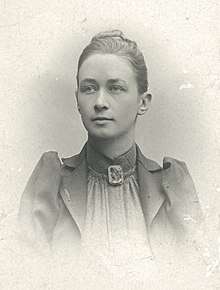 Portrait photo c. 1901 or earlier | |
| Born | October 26, 1862 |
| Died | October 21, 1944 (aged 81) |
| Resting place | Galärvarvskyrkogården, Stockholm, Sweden |
| Nationality | Swedish |
| Education | Tekniska skolan, Royal Swedish Academy of Arts |
| Known for | Painting |
| Movement | naturalism, abstract art |
Early life
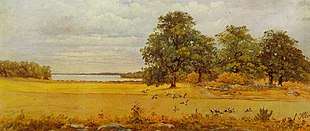
The fourth child of Captain Victor af Klint, a Swedish naval commander, and Mathilda af Klint (née Sonntag), Hilma af Klint spent summers with her family at their manor Hanmora on the island of Adelsö in Lake Mälaren. In these idyllic surroundings Hilma came into contact with nature at an early stage in her life; and this deep association with natural forms was to be an inspiration in her work. Later in life, Hilma af Klint came to live on a permanent basis at Munsö, an island next to Adelsö.
From her family, Hilma af Klint inherited a great interest for mathematics and botany. She showed an early ability in visual art, and after the family moved to Stockholm, she studied at Tekniska skolan in Stockholm (Konstfack today), where she learned portraiture and landscape painting. She was admitted at the Royal Academy of Fine Arts at the age of twenty.[4] During the years 1882–1887 she studied mainly drawing, and portrait- and landscape painting. She graduated with honors, and was allocated a scholarship in the form of a studio in the so-called "Atelier Building" (Ateljébyggnaden), owned by The Academy of Fine Arts in the crossing between Hamngatan and Kungsträdgården in central Stockholm. This was the main cultural hub in the Swedish capital at that time. The same building also held Blanch's Café and Blanchs Art Gallery, where the conflict stood between the conventional art view of the Academy of Fine Arts, and the opposition movement of the "Art Society" (Konstnärsförbundet), inspired by the French En Plein Air painters. Hilma af Klint began working in Stockholm, gaining recognition for her landscapes, botanical drawings, and portraits.[5]
Her conventional painting became the source of financial income. But her 'life's work' remained a quite separate practice.[6]
Spiritual and philosophical ideas

In 1880 her younger sister Hermina died, and it was at this time that the spiritual dimension of her life began to develop.[7] Her interest in abstraction and symbolism came from Hilma af Klint's involvement in spiritism, very much in vogue at the end of the 19th and beginning of the 20th century. Hilma's first experiments in spiritual investigation began in 1879.[4] Hilma af Klint became interested in the Theosophy of Madame Blavatsky and the philosophy of Christian Rosencreutz. In 1908 she met Rudolf Steiner, the founder of the Anthroposophical Society, who was on a visit to Stockholm.[8] Steiner initiated her in his own theories regarding the Arts, and would have a certain influence on her paintings later in life. Several years later, in 1920, she met him again at the Goetheanum in Dornach, Switzerland, the headquarters of the Anthroposophical Society. Between 1921 and 1930 she spent long periods at the Goetheanum.
Af Klint's work can be understood in the wider context of the Modernist search for new forms in artistic, spiritual, political and scientific systems at the beginning of the 20th century.[9] One will find the same interest in spirituality in other artists during this same period, such as Wassily Kandinsky, Piet Mondrian, Kasimir Malevitch and the French Nabis of which many were, like af Klint, inspired by the Theosophical Movement.[10] However, the artistic transition to abstract art and the nonfigurative painting of Hilma af Klint would occur without any contacts with the contemporary modern movements.
The works of Hilma af Klint are mainly spiritual, and her artistic work is a consequence of this.[11]
Work
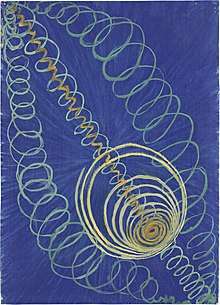
At the Academy of Fine Arts she met Anna Cassel, the first of the four women with whom she later worked in "The Five" (De Fem), a group of artists who shared her ideas, Cassel, Cornelia Cederberg, Sigrid Hedman, and Mathilda Nilsson. ''The Five'' began their association as members of the Edelweiss Society, which embraced a combination of the Theosophical teachings of Helena Blavatsky and spiritualism. The group of female artists The Five was engaged in the paranormal and regularly organized spiritistic séances.[4] They opened each meeting with a prayer, followed by a meditation, a Christian sermon, and a review and analysis of a text from the New Testament. All of this would then be followed by a séance.[4] They recorded in a book a completely new system of mystical thoughts in the form of messages from higher spirits, called The High Masters ("Höga Mästare"). One, Gregor, spoke thus: "All the knowledge that is not of the senses, not of the intellect, not of the heart but is the property that exclusively belongs to the deepest aspect of your being...the knowledge of your spirit".[12]
Through her work with the group The Five Hilma af Klint created experimental automatic drawing as early as 1896, leading her towards an inventive geometric visual language capable of conceptualizing invisible forces both of the inner and outer worlds. She explored world religions, atoms, and the plant world and wrote extensively about her discoveries.[4] As she got more familiar with this form of expression, Hilma af Klint was assigned by the High Masters to create the paintings for the "Temple" – however she never understood what this "Temple" referred to. Hilma af Klint felt she was being directed by a force that would literally guide her hand. She wrote in her notebook:
The pictures were painted directly through me, without any preliminary drawings, and with great force. I had no idea what the paintings were supposed to depict; nevertheless I worked swiftly and surely, without changing a single brush stroke.[13]
In 1906, after 20 years of artistic works, and at the age of 44, Hilma af Klint painted her first series of abstract paintings.
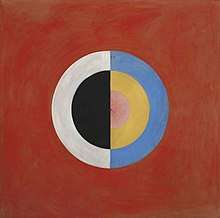
The work for the Temple ran between 1906 and 1915, carried out in two phases with an interruption between 1908 and 1912. As Hilma af Klint discovered her new form of visual expression, she developed a new artistic language. Her painting became more autonomous and more intentional. The spiritual would however continue being the main source of creativity throughout the rest of her life.
The collection for the Temple counts in total 193 paintings, grouped in several sub-series. The major paintings, dated 1907, are extremely large in size: each painting measures approximately 240 x 320 cm. This series, called The Ten Largest, describes the different phases in life, from early childhood to old age.
Quite apart from their diagrammatic purpose the paintings have a freshness and a modern aesthetic of tentative line and hastily captured image: a segmented circle, a helix bisected and divided into a spectrum of lightly painted colours. The artistic world of Hilma af Klint is impregnated with symbols, letters and words. The paintings often depict symmetrical dualities, or reciprocities: up and down, in and out, earthly and esoteric, male and female, good and evil. The colour choice is throughout metaphorical: blue stands for the female spirit, yellow for the male one, and pink / red for physical / spiritual love. The Swan and the Dove, names of two series of the Paintings for the Temple, are also symbolic, representing respectively transcendence and love. As gates to other dimensions, her paintings call for interpretation on a narrative, esoteric and artistic level while evoking primordial geometry and humanistic motifs.[14]
When Hilma af Klint had completed the works for the Temple, the spiritual guidance ended. However, she pursued abstract painting, now independently from any external influence.[15] If the paintings for the Temple were mostly oil paintings, she now also used watercolours. Her later paintings are significantly smaller in size. She painted among others a series depicting the stand-points of different religions at various stages in history, as well as representations of the duality between the physical being and its equivalence on an esoteric level. As Hilma af Klint pursued her artistic and esoteric research, it is possible to perceive a certain inspiration from the artistic theories developed by the Anthroposophical Society from 1920 onward.
All through her life, Hilma af Klint would seek to understand the mysteries that she had come in contact with through her work. She produced more than 150 notebooks with her thoughts and studies.[16]
Hilma af Klint never dared to show her abstract work to her contemporaries. Her major work, the one dedicated to the Temple, had been questioned and rejected by Rudolf Steiner. Hilma af Klint drew the conclusion that her time was not yet ready to understand them. More than 1200 paintings and drawings were carefully stored away in her atelier, waiting for the future.
Hilma af Klint died in Djursholm, Sweden[17] in 1944, nearly 82 years old, in the aftermath of a traffic accident, having only exhibited her works a handful of times, mainly at spiritual conferences and gatherings.[18]
Legacy
In her will, Hilma af Klint left all her abstract paintings to her nephew, vice-admiral Erik af Klint of the Royal Swedish Navy. She specified that her work should be kept secret for at least 20 years after her death. When the boxes were opened at the end of the 1960s, very few persons had knowledge of what would be revealed.
In 1970 her paintings were offered as a gift to Moderna Museet in Stockholm, which declined the donation. Thanks to the art historian Åke Fant, her art was introduced to an international audience in the 1980s, when he presented her at a Nordik conference in Helsinki in 1984. Erik af Klint then donated thousands of drawings and paintings to a foundation bearing the artist's name in the 1970s.[19]
The collection of abstract paintings of Hilma af Klint counts more than 1200 pieces. It is owned and managed by the Hilma af Klint Foundation[20] in Stockholm, Sweden. In 2017, Norwegian architectural firm Snøhetta presented plans for an exhibition centre dedicated to af Klint in Järna, south of Stockholm, with estimated building costs of between €6 million and €7.5 million.[21] In February 2018, the Foundation signed a long-term agreement of cooperation with the Moderna Museet, thereby confirming the perennity of the Hilma af Klint Room, i.e. a dedicated space at the museum where a dozen works of the artist are shown on a continuous basis.[22]
Cultural references
- Hilma af Klint and her work are presented in the movie Personal Shopper, in which the main character researches art that is inspired by spirits.[23]
- The art of Hilma af Klint inspired Acne Studios for the summer collection of 2014.[24]
- The work of Hilma af Klint is cited by Jane Weaver as inspiration for Modern Kosmology.[25]
- In 2020 German film director Halina Dyrschka premiered Beyond the Visible—Hilma af Klint, a feature documentary.[26]
Exhibitions (posthumous)
The abstract work of Hilma af Klint was shown for the first time at the exhibition "The Spiritual in Art, Abstract Painting 1890–1985" organized by Maurice Tuchman in Los Angeles in 1986. This exhibition was the starting point of her international recognition.
Selected exhibitions
- The Spiritual in Art: Abstract Painting 1890–1985, Los Angeles County Museum of Art, Los Angeles, USA. November 23, 1986 – March 8, 1987.[27] Travelling exhibition : Museum of Contemporary Art, Chicago, USA. April 17 – July 19, 1987 ; Gemeentemuseum Den Haag, Netherlands. September 1 – November 22, 1987
- Hilma af Klints hemliga bilder, Nordic Art Association, Sveaborg Helsinki, Finland 1988–1989
- The Secret Pictures by Hilma af Klint, MoMA PS1, Queens, NY, USA. January 15 – March 12, 1989
- Ockult målarinna och abstrakt pionjär, Moderna museet Stockholm, Sweden 1989–1991. Travelling exhibition : Göteborgs Konsthall, Gothenburg, Sweden ; Lunds Konsthall, Lund, Sweden ; Fyns Kunstmuseum, Denmark.
- Okkultismus und Abstraktion, Die Malerin Hilma af Klint, Albertina, Vienna, Austria 1991–1992. Travelling exhibition : Kunsthaus Graz, Austria ; Modern Museum of Passau, Germany
- Målningarna till templet (The paintings to the Temple), Liljevalchs konsthall, Stockholm, Sweden 1999–2000
- 3 x Abstraction: New Methods of Drawing, The Drawing Center, New York, USA 2005–2006;[28] Santa Monica Museum of Art, USA;[29] Irish Museum of Modern Art, Dublin, Ireland 2005–2006
- An Atom in the Universe, Camden Arts Centre, UK 2006[30]
- The Alpine Cathedral and The City-Crown, Josiah McElheny. Moderna Museet, Stockholm, Sweden. December 1, 2007 – March 31, 2008 (represented by 14 paintings)
- The Message. The Medium as artist – Das Medium als Künstler Museum in Bochum, Germany. February 16 – April 13, 2008 (represented by 4 paintings)
- Traces du Sacré Centre Pompidou, Paris, France. May 7 – August 11, 2008. (represented by 7 paintings)
- Hilma af Klint – Une modernité rélévée Centre Culturel Suédois, Paris, France. April – August 2008 (represented by 59 paintings)
- Traces du Sacré Haus der Kunst, Munich, Germany. September 18, 2008 – January 11, 2009
- De geheime schilderijen van Hilma af Klint, Museum voor Moderne Kunst, Arnhem, Netherlands. March 7, 2010 – May 30, 2010[31]
- Beyond Colour, See! Colour! – Four exhibitions at the Cultural Center in Järna, South of Stockholm, Sweden. James Turrell, Rudolf Steiner, May 14 – Oktober 2, 2011
- Hilma af Klint – a Pioneer of Abstraction was produced by and showed at Moderna Museet in Stockholm, Sweden, from February 16 until May 26, 2013,[32] before touring to Hamburger Bahnhof – Museum für Gegenwart in Berlin, Germany, from June 15 to October 6; Museo Picasso Málaga, Spain, from October 21, 2013 to February 9, 2014;[33] Louisiana Museum of Modern Art, Humblebaek, Copenhaguen, Denmark 2014;[34] Henie Onstad Kunstsenter, Oslo, Norway 2015; Kumu, Tallinn, Estonia 2015
- Works by af Klint was exhibited at the Central Pavilion of the 55th Venice Biennial, Italy. June 1 – November 24, 2013.
- Cosa mentale – Imaginaries of Telepathy of the 20th-Century Art , Centre Pompidou, Metz, France. 28 oktober 2015 – 28 mars 2016[35] (9 paintings)
- Painting the Unseen, Serpentine Galleries, London, UK. March 3 – May 15, 2016[36]
- The Keeper, New Museum of Contemporary Art, New York, USA July 20 – October 2, 2016[37]
- Beyond Stars – The Mystical Landscape from Monet to Kandinsky, Musée d'Orsay, Paris, France. March 14 – June 25, 2017[38] (1 painting)
- Jardin infini. De Giverny à l’Amazonie, Centre Pompidou, Metz, France. March 18 – August 28, 2017[39] (7 paintings)
- L’emozione dei COLORI nell’arte, Galleria civica d'arte moderna e contemporanea GAM of Turin, Italy. March 14 – July 23, 2017[40]
- As Above, So Below, Irish Museum of Modern Art, Dublin, Ireland. April 13 – August 27, 2017[41][42]
- Intuition, Palazzo Fortuny in Venice, Italy. May 13 – November 26, 2017[43]
- Göteborg International Biennial for Contemporary Art (GIBCA), Göteborgs Konsthall in Gothenburg, Sweden. September 9 – November 19, 2017[44]
- Hilma af Klint, Pinacoteca do Estado de São Paulo in São Paulo, Brazil. March 3 - July 16, 2018[45]
- Hilma af Klint: Paintings for the Future, Solomon R. Guggenheim Museum in New York, USA. October 12, 2018 – April 23, 2019[46][47]
Gallery
 Group X, No. 1, Altarpiece, 1915
Group X, No. 1, Altarpiece, 1915.jpg) Group X, No. 2, Altarpiece, 1915
Group X, No. 2, Altarpiece, 1915.jpg) Evolution, No. 13, Group VI, 1908
Evolution, No. 13, Group VI, 1908.jpg) Group IX/UW, No. 25, The Dove, No. 1, 1915
Group IX/UW, No. 25, The Dove, No. 1, 1915.jpg) Group IX/SUW, The Swan, No. 1, 1915
Group IX/SUW, The Swan, No. 1, 1915.jpg) Group IX/SUW, The Swan, No. 7, 1915
Group IX/SUW, The Swan, No. 7, 1915.jpg) Group IX/SUW, The Swan, No. 9, 1915
Group IX/SUW, The Swan, No. 9, 1915.jpg) The Swan, No. 10, Group IX/SUW, 1915
The Swan, No. 10, Group IX/SUW, 1915.jpg) The Swan, No. 12, Group IX/SUW, 1915
The Swan, No. 12, Group IX/SUW, 1915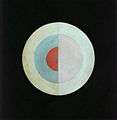 The Swan, No. 16, Group IX/SUW, 1915
The Swan, No. 16, Group IX/SUW, 1915 The Swan, No. 18, Group IX/SUW, 1915
The Swan, No. 18, Group IX/SUW, 1915 Notebook, July 2–11, 1919
Notebook, July 2–11, 1919 Buddha's Standpoint in the Earthly Life, No. 3a, Series XI, 1920
Buddha's Standpoint in the Earthly Life, No. 3a, Series XI, 1920
See also
Publications
- The Spiritual in Art, Abstract Painting 1890-1985, publ. Los Angeles County Museum of Art, 1986. ISBN 0-89659-669-9, ISBN 0-87587130-5 LACMA : pbk
- (in Swedish) Hilma af Klint, Raster Förlag, Stockholm. Swedish text, about 100 pictures. ISBN 91-87214-08-3
- (in Swedish) Vägen till templet, Rosengårdens Förlag. Swedish text, 30 sketches. Describes the teaching period to become a medium. ISBN 91-972883-0-6
- (in Swedish) Enheten bortom mångfalden, Rosengårdens Förlag. Swedish text, 32 pictures. Two parts, one philosophical and one art-scientific. ISBN 91-972883-4-9
- I describe the way and meanwhile I am proceeding along it, Rosengårdens Förlag. A short introduction in English with 3 pictures. ISBN 91-972883-2-2
- 3 X Abstraction, Catherine de Zegher and Hendel Teicher (eds.), Yale University Press and The Drawing Center, NY, 2005 ISBN 978-0300108262 ISBN 0300108265
- (in German) Okkultismus und Abstraktion, die Malerin Hilma af Klint, Åke Fant, Albertina, Wien 1992, ISBN 3-900656-17-7.
- (in Danish) Mod Lyset - Belyj, Goethe, Hilma af Klint, Jeichau, Kandinsky, Martinus, Rosenkrantz, Steiner Gl. Holtegaard & Nordjyllands Kunstmuseum. 2004. ISBN 87-884995-2-9
- Hilma af Klint, the Greatness of Things, John Hutchinson (Hrsg.), Douglas Hyde Gallery, Dublin 2005. English text, 23 images. ISBN 0-907660-99-1.
- The Message. Art and Occultism. With an Essay by André Breton. Hrsg. v. Claudia Dichter, Hans Günter Golinski, Michael Krajewski, Susanne Zander. Kunstmuseum Bochum. Walther König: Köln 2007, ISBN 978-3-86560-342-5.
- Swedish Women Artists: Sigrid Hjertén, Hilma af Klint, Nathalie Djurberg, Signe Hammarsten-Jansson, Aleksandra Mir, Ulrika Pasch, Books LCC, 2010. ISBN 978-1155646084
- The Legacy of Hilma af Klint: Nine Contemporary Responses (English / German), Ann-Sofi Norin, Daniel Birnbaum, Verlag Der Buchhandlung Walther Konig, 2013. ASIN B00FOT4GAM
- Hilma af Klint. The Art of Seeing the Invisible, by Kurt Belfrage, Louise Almqvist (eds.), 2015 ASIN B01K3I9A1S
- Hilma af Klint – A Pioneer of Abstraction, Edited by Iris Müller-Westermann with Jo Widoff, with contributions by David Lomas, Pascal Rousseau and Helmut Zander, exhibition catalogue of Moderna Museet nr 375, 2013. ISBN 978-91-8624-348-7
- Hilma af Klint – Painting the Unseen, Edited by Daniel Birnbaum and Emma Enderby, with contributions by Julia Peyton-Jones, Hans Ulrich Obrist, Jennifer Higgie and Julia Voss. Serpentine Galleries / Koenig Books, 2016. ISBN 978-1-908617-34-7
- (in Swedish) Hilma – en roman om gåtan Hilma af Klint (Hilma – a novel about the enigma Hilma af Klint), Anna Laestadius Larsson, ed. Piratförlaget, publ. 24.05.2017 ISBN 978-91-642-0489-9
- Hilma af Klint – Seeing is Believing, Kurt Almqvist and Louise Belfrage, König Books, 07.10.2017 ISBN 9783960981183
- (in French) Ni vues, Ni connues pages 42–44, Collectif Georgette Sand, Publisher Hugo Doc collection Les Simone, 05.10.2017 ISBN 9782755635393
- Hilma af Klint: Notes and Methods, With an Introduction and Commentary by Iris Müller-Westerman, University of Chicago Press, 2018 ISBN 978-0-226-59193-3
- (in German) Hilma af Klint – »Die Menschheit in Erstaunen versetzen«, biography by Julia Voss, S. Fischer, Frankfurt am Main 2020 ISBN 978-3-10-397367-9
References
- Cain, Abigail. "What Was the First Abstract Artwork?". Artsy.net. Retrieved 2017-03-31.
- Voss, Julia. "The first abstract artist? (And it's not Kandinsky)". www.tate.org.uk. Tate Modern. Retrieved 22 May 2015.
- Bashkoff, T., ed., et al., Hilma Af Klint (New York: Solomon R. Guggenheim Museum, 2018).
- Klint, Hilma af (2018). Hilma af Klint : Notes and Methods. The University of Chicago Press. ISBN 9780226591933. OCLC 1090316599.
- "Hilma af Klint: Painting the Unseen". Serpentine Galleries. Retrieved 2017-03-11.
- Cattelan, M., Gioni, M., & Subotnick, A., eds., Charley, Issue 5 (New York: D.A.P., 2007).
- Kellaway, Kate (2016-02-21). "Hilma af Klint: a painter possessed". The Guardian. ISSN 0261-3077. Retrieved 2017-03-11.
- Gaze, D., Concise Dictionary of Women Artists (Abingdon-on-Thames: Routledge, 2001), p. 413.
- Liam Taft – Invisible art: rediscovering the work of Hilma af Klint National Student, April 19, 2017
- Theosophy and the Society in the Public Eye
- [Hilma af Klint – Painting the Unseen Serpentine Galleries, 2016. ISBN 978-1-908617-34-7, p.24]
- Heiser, J., & Higgie, J., eds., Frieze: Contemporary Art and Culture, Vols 88-91 (London: Durian Publications, 2004).
- Iris Müller-Westermann – Paintings for the Temple – Moderna Museet Stockholm
- Erkan, Ekin. "Hilna Af Klint at The Guggenheim: Metaphysics as it Patrols Mortality's Borders". AEQAI. Retrieved 7 September 2019.
- Fiore, J., "How the Swedish Mystic Hilma af Klint Invented Abstract Art", Artsy, October 12, 2018.
- Witt, Karolina. "Hilma af Klint Tempelbilderna och historieskrivningen" (PDF). www.diva-portal.org. Halmstad University. Retrieved 4 Dec 2015.
- Phaidon Editors (2019). Great women artists. Phaidon Press. p. 24. ISBN 978-0714878775.
- Wolfe, S., "Lost (and Found) Artist Series: Hilma af Klint", Artland, October 2018.
- Clemens Bomsdorf (April 13, 2017), Museum for pioneer of abstraction Hilma af Klint is stuck in limbo The Art Newspaper.
- Foundation Hilma af Klint
- Clemens Bomsdorf (April 13, 2017), Museum for pioneer of abstraction Hilma af Klint is stuck in limbo The Art Newspaper.
- More Hilma af Klint at Moderna Museet, 26 February 2018
- Stewart, S., "Kristen Stewart’s ‘Personal Shopper’ will get under your skin", New York Post, March 7, 2017.
- Acne Studios – Projects – Hilma af Klint
- Williams, H. (2017-07-10). "Jane Weaver on the mystical inspiration for her space rock". The Independent. Retrieved 2018-01-15.
- King, J. P., "New doc Hilma af Klint reclaims female artist’s place in history", Washington Blade, February 4, 2020.
- Art view; How the spiritual infused the abstract – New York Times, Published December 21, 1986
- 3 x Abstraction – The Drawing Center
- 3 x Abstraction – Santa Monica Museum of Art Archived 2017-08-20 at the Wayback Machine
- Out of this World – The Guardian, Published March 14, 2006
- The Secret Painter Hilma af Klint at MMKA – Metropolis M, Published April 23, 2010
- Hilma af Klint – A Pioneer of Abstraction, Moderna museet Stockholm
- Hilma af Klint – a Pioneer of Abstraction, Museo Picasso Málaga
- Hilma af Klint – a Pioneer of Abstraction, Louisiana Museum of Modern Art
- (in French) Cosa mentale – Imaginaries of Telepathy of the 20th-Century Art , Centre Pompidou – Metz (read 08-04-2017)
- Hilma af Klint : Painting the Unseen, Serpentine Galleries
- The Keeper, New Museum of Contemporary Art
- Beyond Stars – The Mystical Landscape from Monet to Kandinsky, Musée d'Orsay Archived 2017-02-02 at the Wayback Machine
- (in French) Jardin infini. De Giverny à l’Amazonie, Centre Pompidou Metz
- L’emozione dei COLORI nell’arte
- As Above, So Below
- Aidan Dunne -An alternative history of art of the last century Irish Times, April 18, 2017
- Intiuition, Axel Vervoodt Foundation
- GIBCA 2017
- Hilma af Klint, Pinacoteca in Sao Paolo
- Hilma af Klint, Guggenheim
- Smith, R., "'Hilma Who?' No More", The New York Times, Oct 11, 2018.
External links
| Wikimedia Commons has media related to Hilma af Klint. |
- Publications by and about Hilma af Klint in the catalogue Helveticat of the Swiss National Library
- Literature by and about Hilma af Klint in the German National Library catalogue
- Hilma af Klint at Library of Congress Authorities
- Guggenheim Museum, Hilma af Klint, YouTube, 2018.
- Guggenheim Museum, https://www.youtube.com/watch?v=BKyzGZ3E_oU, YouTube, 2018
- Hilma af Klint Foundation
- Presentation of Hilma af Klint on Youtube (In Swedish with English subtitles, 22 Min.)
- Hilma af Klint at Prabook